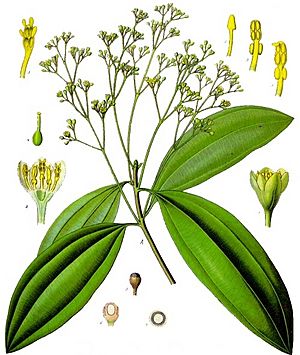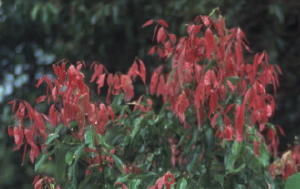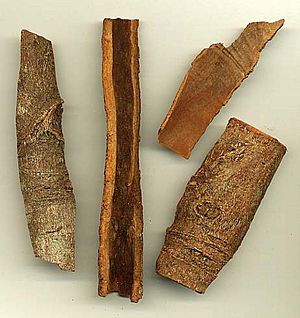Cinnamomum cassia facts for kids
Quick facts for kids Cinnamomum cassia |
|
|---|---|
 |
|
| From Koehler's Medicinal-Plants (1887) | |
| Scientific classification | |
| Genus: |
Cinnamomum
|
| Species: |
cassia
|
| Synonyms | |
|
|
Cinnamomum cassia, often called Chinese cassia or Chinese cinnamon, is an evergreen tree. This means it keeps its green leaves all year round. It originally comes from southern China. Today, it is grown in many parts of South and Southeast Asia. Countries like India, Indonesia, Laos, Malaysia, Thailand, and Vietnam grow it.
This tree is one of several Cinnamomum species. People use its bark as a spice because it smells and tastes wonderful. The small buds of the tree are also used as a spice. They are especially popular in India and were even used by ancient Romans.
The Chinese cassia tree can grow quite tall, reaching about 10 to 15 meters (33–49 feet). It has grayish bark. Its leaves are long and hard, about 10 to 15 centimeters (4–6 inches) in length. When the leaves are young, they have a reddish color.
Contents
Exploring Cinnamon Varieties

Chinese cassia is closely related to other types of cinnamon. These include Ceylon cinnamon (C. verum), which is sometimes called "true cinnamon." There's also Saigon cinnamon (C. loureiroi), known as "Vietnamese cinnamon." Other types are Indonesian cinnamon (C. burmannii), also called "korintje," and Malabar cinnamon (C. citriodorum) from India.
For all these cinnamon types, the dried bark is used as a spice. Chinese cassia has a flavor that is not as delicate as Ceylon cinnamon. Its bark is thicker and harder to grind. It also feels rougher than Ceylon cinnamon bark.
Where Does Cassia Come From?
Chinese cassia is grown in both China and Vietnam. For a long time, Vietnam was the biggest producer of Saigon cinnamon. This type has a lot of natural oils, which gives it a very strong flavor.
However, during the Vietnam War, it became harder to get cinnamon from Vietnam. So, farmers in the highlands of Indonesia started growing more Indonesian cassia. This helped meet the world's demand. Indonesian cassia has the least amount of natural oils. Because of this, it is usually the cheapest type. Chinese cassia tastes sweeter than Indonesian cassia. Its flavor is similar to Saigon cinnamon, but it has less oil.
Using Cassia Bark
Cassia bark is used in many ways, both as a powder and in whole "stick" form. It adds flavor to sweets, desserts, and baked goods. It's also a key ingredient in many curry recipes. Ceylon cinnamon is less suitable for these dishes.
Sometimes, cassia is mixed with Ceylon cinnamon. However, cassia is much thicker and coarser. You can tell cassia sticks apart from Ceylon cinnamon sticks. Ceylon cinnamon sticks have many thin layers. They are easy to grind into powder. Cassia sticks, on the other hand, are very hard. They are usually made of one thick layer.
Cassia Buds: A Special Spice
Cassia buds are not as common, but they are also used as a spice. They look a bit like cloves. They have a mild, flowery cinnamon flavor. Cassia buds are mostly used in old-fashioned recipes. You might find them in pickling mixtures, marinades, and some teas.
Cassia in Traditional Medicine
Chinese cassia is called ròuguì (肉桂) in Chinese. It is mainly grown in the southern provinces of Guangxi, Guangdong, and Yunnan. It is considered one of the 50 important herbs in traditional Chinese medicine. Scientists have found many natural compounds in Cinnamomum cassia.
Some health agencies in Europe have warned about eating too much cassia. This is because it contains a natural compound called coumarin. If you eat very large amounts of coumarin, it could potentially affect your liver. Other natural compounds found in cassia bark and its oils are cinnamaldehyde and styrene. It's always best to use spices in moderation.
A Look Back in Time
Chinese herbalists mentioned cassia bark as far back as 2700 B.C. This suggests people have been using it for a very long time. In ancient times, it was used to help with issues like diarrhea and fevers. Healers in India, known as Ayurvedic healers, also used it for similar purposes.
Around 500 B.C., cassia cinnamon arrived in Egypt. There, it became a valuable part of their embalming mixtures. The ancient Greeks, Romans, and Hebrews were among the first to use cassia bark for cooking. They also made perfumes with it and used it for health reasons. The Bible even mentions it as part of a special anointing oil used by Moses. Cinnamon spread with the Romans. By the 17th century, it was commonly used in cooking across Europe.
Images for kids
See also
 In Spanish: Cinnamomum cassia para niños
In Spanish: Cinnamomum cassia para niños




